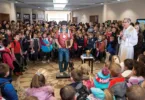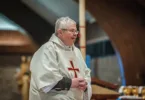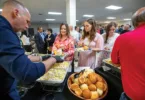
by Maggie MacFarland Phillips
Special to The Leaven
LEAVENWORTH — In many ways, the St. Ignatius Catholic Community at Fort Leavenworth here is no different than any other Catholic community dealing with COVID-19 restrictions: limited capacity, no holy water in the fonts, less singing and, of course, masks.
What sets worship apart at the oldest continuously active military reservation west of the Missouri River comes down to two additional congregations: prisoners and Protestants.
As Lent begins, Father Jason Hesseling, Fort Leavenworth’s Catholic chaplain, and his staff are like any parish working to minister to the needs of parishioners during the twin seasons of Lent and COVID.
Unlike their civilian counterparts, however, the recently arrived Father Hesseling and his staff must follow not just the guidance of the Army and the Archdiocese of the Military Services, but the requirements of Fort Leavenworth’s non-Catholic garrison (post) chaplain, which are informed by the state and local government guidelines.
Responding to an email asking for comment, Father Hesseling could at first blush be nearly any civilian priest in the era of COVID.
“For Catholics,” he explained, “Lent is a time of greater spiritual intensity where we are called to spend more time engaged in spiritual practices and devotions. While it’s true that God is just as present in my living room as in a cathedral, it is also true that we are generally more receptive to God’s presence in the cathedral. The space of a chapel is designed to foster spiritual growth and a sense of the divine. The actions particular to Lent, such as wearing ashes on our foreheads or walking the Stations of the Cross or holding blessed palm branches, are also external aids which lose their effectiveness outside normal worship services and spaces.”
The central questions the church around the world is grappling with during this pandemic, he said, are: “How do we intensify our spiritual lives without the external supports built into our chapel facilities — the ‘smells and bells’ — particular to Lent? How do we foster and build relationships which sustain our faith outside of large worship services and gatherings?”
These considerations are compounded at the fort by the presence of the U.S. Disciplinary Barracks and the Midwest Joint Regional Correctional Facility whose Catholic populations demand an additional priest to administer the sacraments.
In some ways, compared to the challenges of accommodating the service members and their families, those presented by the prisons are fairly straightforward.
Father Roderic Giller, OSB, a member of St. Benedict’s Abbey in Atchison, was contracted to resume Mass, confessions, counseling and more in November of last year after inmates experienced a sacramental hiatus of nine months — the result of budget issues compounded by pandemic-related restrictions.
Now at the Disciplinary Barracks, Father Roderic, assisted by Father Duane Roy, OSB, rotates between six pods of around 60 inmates each, saying Mass for about three or four Catholic inmates at a time. Since November, Father Roderic has conducted baptisms and confirmations, and is currently preparing another inmate to be received into the Catholic Church.
Father Roderic’s and Father Duane’s prison ministry enables Father Hesseling to focus on his flock of active-duty service members and their families at Fort Leavenworth, where he serves as the sole priest for its Catholic community.
That’s a challenge in and of itself, but Father Hesseling also has a day job at the U.S. Army’s Mission Command Center of Excellence at its Combined Arms Doctrine Directorate, supporting its mission to effectively prepare soldiers and leaders for war.
Meanwhile, in his pastoral duties — like many priests today — he is often a one-man show, supported by a small staff and dedicated volunteers as he says multiple Masses on Sundays and holy days to accommodate smaller COVID-compliant congregations of no more than 15 families at a time, per garrison rules.
“The primary challenge for military chapels is that chapels are one of the primary hubs to build a sense of community,” Father Hesseling says of the current prohibitions. “[R]elationships are hard to maintain and next to impossible to build over a virtual medium. Reducing capacity, eliminating food/beverages and keeping families socially distant all make it more challenging to conduct effective ministry and build vibrant chapel communities.”
To confront this widespread pastoral problem, Father Hesseling has a unique resource that civilian priests do not — his fellow Army chaplains of other denominations.
At a recent meeting with his staff over Zoom, attendees puzzled over how to conduct Ash Wednesday, Lent, Holy Week and the Triduum in compliance with the Army and the garrison’s COVID guidance. The agenda items would have sounded familiar to almost any civilian priest these days, until the subject of Palm Sunday arose.
How, it was asked, was the Protestant service immediately following the 9:30 a.m. Mass to be accommodated?
As the parish staff discussed how to pick up pieces of blessed palm fronds before the Protestant service, they informed Father Hesseling of the Fort Leavenworth Catholic community’s custom of starting Palm Sunday Mass 10 minutes early in order to have time for the blessing of the palms at the beginning, without running long and inconveniencing the Protestant congregation.
Like many Army chapels, the St. Ignatius Catholic Community shares its space with other denominations. Visitors often express surprise when, at the conclusion of Mass, the crucifix turns around to become a simple wooden cross, the Blessed Mother’s statue retreats behind opaque stained glass and the Stations of the Cross are shuttered.
These kinds of ecumenical accommodations aren’t unusual at a military chapel, and Father Hesseling welcomes them, especially during this challenging time.
Fort Leavenworth garrison chaplain Michael McDonald agrees, and is hopeful that if the communities surrounding Fort Leavenworth see encouraging trends with regard to COVID-19 rates, Holy Week may mean the post could allow more of its faithful to attend in-person worship.
“Ultimately,” McDonald believes, “it’s the people that make this work.”
The laity on post, said McDonald, are unique. They “live and they work together, regardless of which service they go to.” They often all go to the same chapel but attend different services and belong to different faith groups.
“You find that, at various times and places and events, you are supporting and lifting each other up and rooting each other on, as each of the services tries to facilitate the best religious support that they can for their specific community,” said McDonald.






